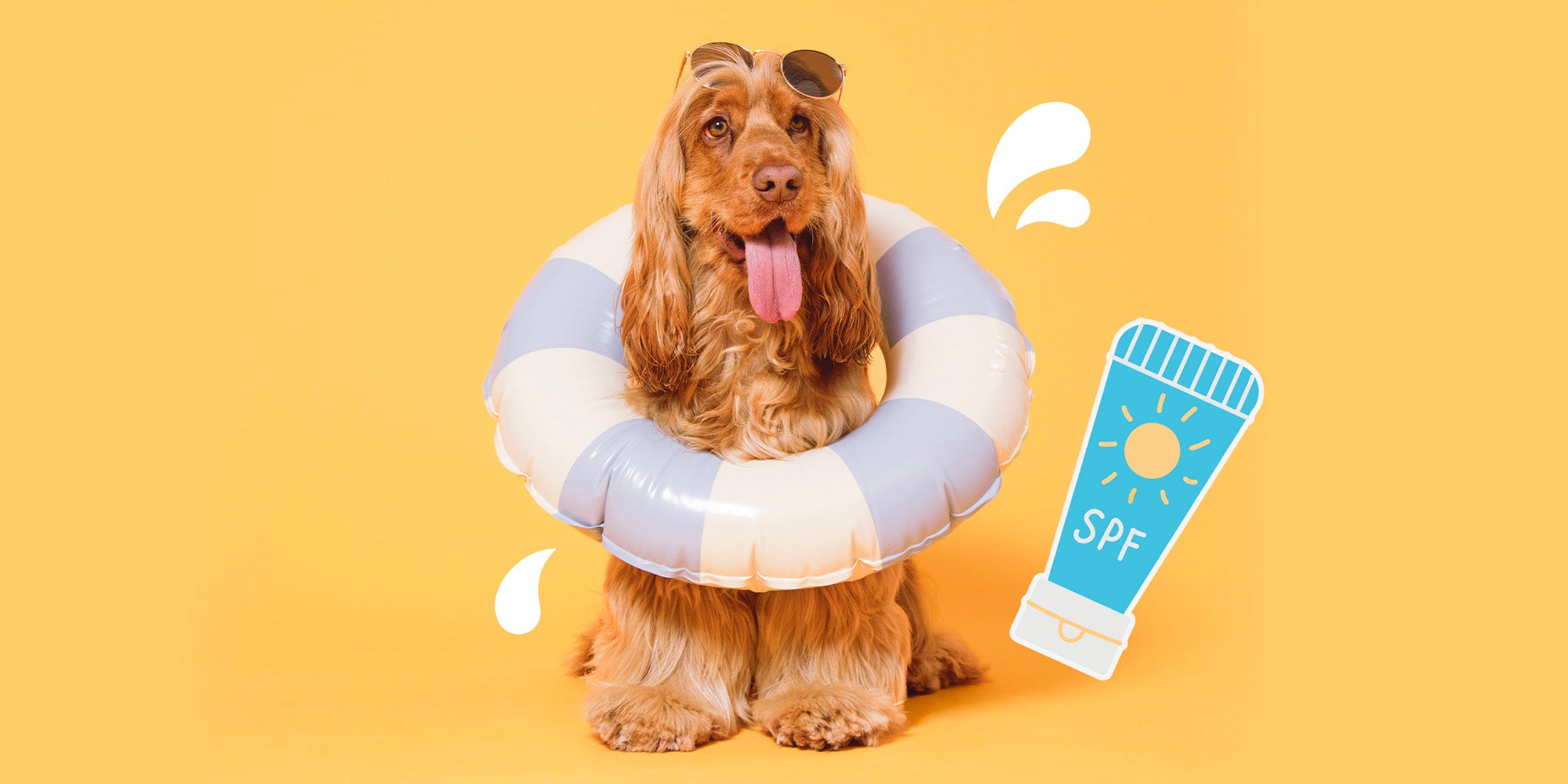FREE UK DELIVERY ON ORDERS OVER £39.99
Most dog owners know from experience that a dog who’s been out in the hot sun becomes far from functional - they may even sit down mid-walk and refuse to move! There are other reasons for your dog to avoid the strongest heat of a summer day, however, and that’s the risk of sunburn.
If you’ve ever been out in the sun with your dog and wondered ‘can a dog get sunburn?’ - the answer is yes, they can - and it’s important to take precautions just as you would with your own easily damaged skin.
Read on as we explain more about sunburn in dogs, signs your dog might be suffering from too much sun, and what you can do to protect your pooch on hot summer days.
Yes, dogs can get sunburn.
As lots of dogs are covered in thick fur, you’d be forgiven for believing they can’t get sunburn or wouldn’t need sun protection, such as sunscreen. Believe it or not, dogs need sunscreen as much as humans do - especially dogs with patches of exposed skin, a thin coat, or if they’re a breed that is susceptible to becoming sunburnt (more on that later).
Still, even a dog with thick fur who’s less at risk of skin damage can get sunburn on their belly, groin area, nose, ears or eyelids.
We all know the sense of growing unease when we’ve been in the sun too long, and the last thing you want is for your dog to be in that same discomfort. As dogs can’t communicate when they feel this way, be aware of the following signs that your dog might be getting sunburnt:
Pink or reddened skin. The most obvious sign of sunburn is reddened skin, especially where they have the shortest hair or their skin is exposed, like on their belly or groin area.
A warm or overly hot body. If you touch your dog, their skin will feel warmer than usual, or even overly hot.
Swelling. If a dog is overheating, parts of their body that are too hot may become swollen.
Flaky or peeling skin. After a dog has been sunburnt, their skin may be itchy and could flake and peel, just as it does for humans when we get severe sunburn.
Pain or soreness. Your dog might cry or whimper when touched in certain areas after being in the sun.
Restlessness or behavioural changes. If it’s a sunny day and your dog can’t seem to relax, or is restless, barking or bothering you, it could be a sign they’re not enjoying their time in the sun and want to go inside.
Scabs and sores. In extreme cases, your pooch may develop scabs or sores if they’ve been severely burned.

As you’d expect, dog breeds with short hair and light-coloured skin or fur are more prone to sunburn than those with long-haired coats or darker skin.
Bulldogs, for example, with their very short hair and upturned noses, are very prone to sunburn; as well as other short-haired breeds like Boxers, Dalmatians, Pitbulls and Greyhounds.
Of course, hairless dog breeds such as the Chinese Crested Dog or the Xoloitzcuintli (Mexican Hairless Dog) are also very at risk of their skin being burnt on a bright day and will require special attention to keep them protected.
Despite this, remember that all dogs can get sunburn, no matter the breed. Dark-coated dogs with light-pigmented noses, such as Collies, are at risk too - or any dog with white colouring or thin hair on their delicate ears and eyelids.
If your pooch has mild sunburn, i.e. slightly reddened skin and an overly warm body, it will likely get better on its own with a little help from you. Mild sunburn in dogs can be treated at home, but if your dog doesn’t seem themselves, appears to be in pain or discomfort, or if the sun damage is visibly severe, it’s important to take them to the vets for a check-up.
Here’s how to help them at home:
If your dog seems out of sorts after a day in the sun, contact your vet so they can give them a thorough check over.
If your dog’s sunburn is severe; i.e. if their discomfort lingers, they seem sensitive to the touch or if there is any blistering or pain, a vet can offer them some stronger, more targeted treatments, such as prescription ointment, painkillers or antibiotics.
Prevention is better than cure, especially when it comes to sun damage - and the best way to beat a nasty case of sunburn is to protect your dog’s skin from exposure in the first place. Remember: if you don’t regularly protect your dog from sunburn you risk other dangerous health conditions such as heatstroke, or even skin cancer.
So when the days start to brighten and temperatures heat up, be sure to take the following precautions for your dog:
Give your pooch plenty of shade. Lots of us would hate to be stuck in the endless glare of the sun without the chance to get shade, so give your pooch the same courtesy and be sure they have plenty of exit routes. This means stopping at shaded spots on a sunny walk, putting up a parasol in the garden, and offering easy access back into the house for whenever they need it.
Use sunblock for dogs. Wherever your dog has areas of exposed skin, even if it’s just their tummy, groin, ears and shaven bits - cover them in specialist dog sun cream to avoid a nasty burn.
Don’t walk them at peak times of day. The hours between 11am and 4pm are usually sweltering for dogs during a hot summer. Try to walk them earlier or later in the day to avoid them catching the sun and getting too hot while exercising.
Keep lots of water nearby. Dogs need hydration during hotter weather, just like us! Ensure their water is cold, frequently changed, topped up and easy to get to.
Sun hats for dogs. Yep - dogs can wear hats for sun protection! If your dog is willing to wear a sun hat, be sure it has a visor that shields their most sun-sensitive areas, like their nose and eyes. You could also try a dog coat, sun shirt or mat made for UV protection.

Dogs have skin that can be easily burnt in the sun, therefore they need sun protection, just as humans do. As you can’t avoid taking your dog outside during warm summer weather, sun cream for dogs is definitely something you should invest in.
Evidence suggests that dogs who suffer from sun-induced skin cancers are usually affected in areas with glabrous skin - meaning a sparsely-haired belly, armpits and groin areas. This makes it all the more important to protect this delicate skin.
You can indeed get sun cream for dogs. There are specialist sunscreens made just for pooches - apply it liberally to exposed skin, areas where their fur is thinner, and on noses, ears and eyelids to create a barrier of sun protection for your pup’s precious skin. And keep reapplying throughout the day!
Be sure to pick a sun cream that’s formulated for your pet - as some of the ingredients in human sun cream aren’t good for dogs, and they’re prone to licking it off and ingesting it.
Sun cream for dogs should ideally be waterproof, have an SPF of at least 30, and not contain zinc oxide or para-aminobenzoic acid (PABA).
If your pooch has spent too much time in the sun and needs to relax and cool down come the evening, soothe their nerves with Pooch & Mutt Calm & Relaxed Dry Dog Food. It contains turkey, rich with L-tryptophan (which helps release happy hormones) and chamomile, a natural relaxant - it’s also totally grain-free. For more information about pooch sunburn or skin protection, feel free to get in touch with us.





Never miss a treat!
Subscribe to our newsletter and get blog articles amongst other treats delivered to your inbox





Comments (0)
Leave a comment